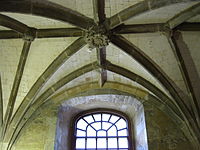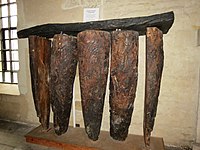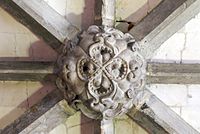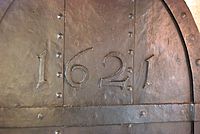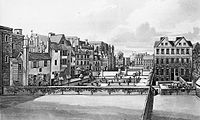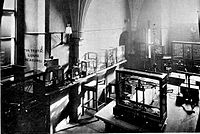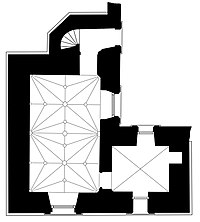Difference between revisions of "Jewel Tower"
(Created page with "{{Infobox building |name=The Jewel Tower |city=Westminster |county=Middlesex |picture=Jewel Tower.jpg |picture caption=The Jewel Tower |os grid ref= |latitude=51.498417 |longi...") |
(No difference)
|
Latest revision as of 23:35, 9 November 2015
| The Jewel Tower | |
|
Middlesex | |
|---|---|
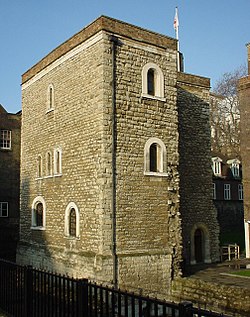 The Jewel Tower | |
| Location | |
| Location: | 51°29’54"N, 0°7’35"W |
| City: | Westminster |
| History | |
| Information | |
| Condition: | Intact |
| Owned by: | English Heritage |
The Jewel Tower is a 14th-century surviving element of the royal Palace of Westminster, in Old Palace Yard in Westminster, Middlesex. It was built between 1365 and 1366, under the direction of William of Sleaford and Henry de Yevele, to house the personal treasure of Edward III. The tower, a three-storey, crenellated stone building, occupied a secluded part of the palace and was protected by a moat linked to the River Thames. The ground floor featured elaborate carved vaulting, described by historian Jeremy Ashbee as "an architectural masterpiece". The tower continued to be used for storing the monarch's treasure and personal possessions until 1512, when a fire in the palace caused Henry VIII to relocate his court to Whitehall.
At the end of the 16th century, the House of Lords began to use the tower to store its parliamentary records, building a house alongside it for the use of the parliamentary clerk, and extensive improvements followed in 1621. The tower continued as the Lords' records office through the 18th century, and several sets of renovations and building work were carried out to improve its fire-proofing and comfort, creating the current appearance of the tower. The tower was one of only four buildings of the Palace of Westminster to survive the devastating fire that ravaged the palace in 1834, and in the aftermath the records were moved to a new, purpose-built archive in the Victoria Tower.
The Jewel Tower was taken over by the newly formed Standard Weights and Measures Department in 1869, who used it for storing and testing official weights and measures. The rising levels of London traffic made the tower increasingly unsuitable for this work, and by 1938 the department had abandoned it in favour of other facilities. In 1948, the building was placed into the care of the Ministry of Works, who repaired the damage inflicted to the tower during the Second World War, and extensively restored the building, clearing the surrounding area and opening the tower for tourists.
In the 21st century, the Jewel Tower is managed by English Heritage.
Contents
History
Middle Ages
The Jewel Tower was built within the Palace of Westminster between 1365 and 1366, on the instructions of King Edward III, to hold his personal treasure.[1] Edward had broadly three types of treasure: his ceremonial regalia, which was usually kept at the Tower of London or held by the Abbot of Westminster; the jewellery and plate belonging to the Crown, which was kept by the Royal Treasurer at Westminster Abbey; and his personal collection of jewels and plate.[2] Edward accumulated what historian Jenny Stratford has described as a "vast store of jewels and plate", and his collection of personal treasure was at its greatest during the 1360s.[3]
Edward had managed this last category of personal treasure through an organisation called the Privy Wardrobe.[4] The Keeper of the Privy Wardrobe was responsible for guarding and recording the king's belongings, and dispatching particular items around the kingdom, potentially giving them as gifts to the monarch's family and friends.[5] The Privy Wardrobe was initially based in the Tower of London in Edward's reign and became focused on handling the supplies for his campaigns in France.[4] This probably encouraged the King to decide to build a new tower in Westminster to host a separate branch of the Privy Wardrobe specifically to manage his personal jewels and plate.[4] In practice, this branch also managed the clothes, vestments and similar goods belonging to the royal household – effectively, the non-military parts of the King's property.[6]
The Jewel Tower was designed and built by Henry de Yevele, a prominent royal architect, supported by a team of masons he commissioned for both this project and a neighbouring piece of work to build a new clock tower nearby.[7] Hugh Herland was taken on as the chief carpenter for both projects.[7] The payments for the project were recorded on a parchment roll eight feet six inches long, now held in the Public Record Office.[1]
The tower was constructed in the secluded south-west corner of the Palace of Westminster, overlooking the King's garden in the Privy Palace, the most private part of Westminster.[8] The tower was positioned so as not to encroach on the existing palace, but this meant it was built on top of land owned by the neighbouring Westminster Abbey.[1] It took six years for the Abbey to convince the King to agree to compensate for them for this annexation.[1]
The tower was linked to the external walls of the palace, and further secured by its moat, which was connected to the River Thames by a channel 148 feet long.[9] The top of its walls were crenelated, and in order to prevent potential intruders there were no windows on the outside of the tower at the ground floor level.[10] The keeper would have worked from the first floor, and Edward's treasure itself was kept on the second floor, in locked chests.[11]
The Jewel Tower continued to be used by Edward's successors for storing treasure and personal possessions, until 1512, when a fire in Westminster Palace forced the royal court of King Henry VIII to relocate to Whitehall, along with the jewels and plate from the tower.[12]
Modern Age
King Henry VIII built a new palace at Whitehall, but he continued to use the tower, then called the "Tholde Juelhous" ("the old Jewel House") for storing his wider household effects, including expensive cloths, linens, royal chess sets and walking sticks, but these appear to have been removed from the tower after his death.[13]
The Jewel Tower diminished in importance; probably during the 16th century, the palace walls on either side of the building were demolished, and part of the moat was filled in during 1551.[14] By the 1590s, the tower had begun to be used both for the storage of the Lords' records and as a house for the parliamentary clerk.[15] In 1600, a three-storey timber extension was built on the side of the tower for the clerk's use, as part of a wider renovation of the tower at a cost of £166, and the complex began to be termed the Parliament Office rather than the Jewel Tower. The ground floor of the tower may have begun to be used as a kitchen and scullery for the new house at around this time.[16]
In 1621, a subcommittee of the House of Lords concluded that the Lords' record keeping should be improved, and the tower was renovated to improve its storage facilities.[17] The first floor of the tower, used to store the documents, was renovated with brick vaulting, providing better fire protection than the original wooden ceiling, by Thomas Hicks at a cost of £6.[18] The chamber was further protected by a new iron door.[19]
The parliamentary clerk continued to live alongside the tower, except during the interregnum of 1649 and 1660, when the House of Lords was temporarily abolished.[20] The sewer feeding into the moat was blocked up around the middle of the century, and the moat, which previously seems to have been kept clean, was allowed to gradually fill up with debris, despite complaints from the House of Lords that this put the Jewel Tower at greater risk of fire and thieves.[21]
By 1716, the tower was reported to Parliament as being in a "ruinous condition", and an enquiry concluded that repairs and restoration should go ahead at a cost of £870. The work commenced under Nicholas Hawksmoor, the Surveyor General, but staff turnover in the Office of Works and accusations of corruption slowed the work.[22] Cut-backs were made, in particular to the plans to strengthen the roof of the tower with fire-resilient brick vaults; despite this, the costs totalled £1,118 by the end of the project in 1719.[22] The outside of the tower was reworked to form its modern appearance, with plainer, larger windows and a simpler parapet, and a new chimney to keep members of the House of Lords warm while they were reading the records.[22] Specialised wooden cupboards and shelves were installed on the first floor to hold the documents.[23] Further work was carried out in 1726 to improve the security and safety of the tower, particularly from the threat of fire, at a cost of £508.[24]
At some point in the 18th century, possibly in 1753, the upper and lower halves of the tower were divided into two separate areas.[25] The spiral staircase from the ground floor kitchen to the upper floors, holding the records, was removed, and a window on the first floor was turned into a doorway so that the upper floors could be accessed from the neighbouring house.[16] A fire-resistant stone vaulted ceiling was installed in on the first floor, possibly also in 1753 at a cost of £350.[16]
An investigation by the Board of Works in 1751 concluded that the parliamentary clerk's house was in a poor condition and unsuitable for habitation.[26] In particular, it lacked a kitchen and scullery, and the cooking was still being carried out in the ground floor rooms of the Jewel Tower.[26] Two three-storey brick houses – later titled 6–7 Old Palace Yard – were built in its place between 1754 and 1755, possibly by the architect Kenton Couse, at a cost of £2,432.[27] The Jewel Tower was accessed from the Old Palace Yard through a central passageway that ran between the houses, and a range of subsidiary buildings were built behind the houses, joining them and the tower, while the tower continued to be used for preparing food.[27]
The new Palace
A fire swept through Westminster in 1834, destroying most of the old palace, but the Jewel Tower, which was separated from the main fire and was positioned away from the prevailing wind, survived, along with its store of records from the House of Lords.[28] The Palace of Westminster was rebuilt, and in 1864 substantial changes were made at the tower: the Parliamentary records in the tower were moved to a fire-proof storage facility at the new Victoria Tower; 6–7 Old Palace Yard ceased to be used by the clerk as a house, and the kitchen in the ground floor of the tower was closed.[29] Around this time, the tower began to be called the Jewel Tower once again, partially in the incorrect belief that it had held the Crown Jewels during the Middle Ages.
In 1866, the Standards of Weights, Measures, and Coinage Act was passed by Parliament, creating a department of the Board of Trade called the Standard Weights and Measures Department.[30] This department was responsible for maintaining the weights and measures used in the country – in particular, the primary and secondary standards, the physical "master" weights and lengths that other measuring devices could be compared against.[31]
The house alongside the Jewel Tower was taken over by the new department in 1869, and the standards and testing equipment were installed in the tower itself, which was felt to be particularly suitable for making scientific measurements, because of its thick walls.[32] The roof, which was in poor condition, was repaired.[33] The ground floor was used as a weighing room and for storing glass fluid measures, the first floor held the standards of length, and the second floor was used as a museum to display old historical equipment.[33]
During the coming decades, however, the suitability of the tower for the work of the department came into question.[33] The condition of the roof remained problematic, and steel girders had to be added to support the main timbers.[34] Increasing traffic levels around the tower led to subsidence and high levels of vibration, effecting the operation of the delicate instruments, and worsened after the opening of Lambeth Bridge in 1932.[33] Some of the department's work was transferred to their Bushy House facility in Teddington in the 1920s, and in 1938 the department relinquished the tower altogether.
In the Second World War, the tower was hit by an incendiary device dropped by German bombers in 1941. The resulting fire caused significant damage to the roof, destroying much of the original fabric.
The tower was placed into the guardianship of the Ministry of Works in 1948. The ministry carried out extensive repairs, attempting to retain a mixture of the mediæval and newer features in the building.[35] They removed the old mediæval elm and oak foundations and replaced them with concrete supports, and installed a replacement roof in 1949, removing the first floor entrance and reinstalling the spiral staircase from the ground floor in 1953. The Jewel Tower was opened for tourists in 1956, and drew between 500 and 800 visitors each week.[36]
The mediæval moat was re-excavated in 1956, and filled with water between 1963 and the 1990s, when its poor water quality led to its being drained and lined with gravel.[37]
Architecture
The Jewel Tower is a three-story building of Kentish Ragstone with a brick parapet, structurally largely unchanged since the 14th century.[38] The walls that once faced away from the palace are finely coursed, but the interior two walls are more crudely finished.[39] The external windows are almost all 18th-century in origin and made from Portland limestone. The jagged remnants of the former palace walls jut out from the sides of the tower.[40] The moat, now dry, stretches away east from the tower, passing by the former landing stage for boats from the Thames, 19.7 feet (6.0 m) long and made from ashlar stone.[41] The clearances of the post-war era mean that there are now few neighbouring buildings to the tower, and it is much more visible than in previous centuries.[42]
The ground floor of the tower is entered from the north, and is made up of two chambers. The windows in the main room are a mixture of early 18th-century designs, combined with a surviving large mediæval window embrasure on the eastern side.[43] The main chamber has elaborate stone vaulting, considered by historian Jeremy Ashbee to be "one of the most impressive mediæval interiors in London... an architectural masterpiece".[43] The vaulting features 16 carved Reigate stone bosses, including grotesque heads, birds, flowers and the devil, some designed to form amusing visual illusions.[44] The ground floor is used by English Heritage as a gift shop and café.
The first floor is reached by a 20th-century spiral staircase, and follows the same two-room design as the first floor.[45] It has a roof of groin-vaulted Portland stone, probably from the 18th century, and the windows are mostly 18th century in origin, with one 20th century reconstruction.[46] The iron door to the larger chamber carries the date of its installation, 1621, and its lock carries the letters "IR", standing for King James I.[47] The neighbouring room is barrel-vaulted in brick, with a recess in the wall that was originally a latrine, and the original 1719 iron-shutters on its north window.[48] The first floor contains an exhibit on the history of Parliament.
The spiral staircase to the second floor is original.[49] The floor continues the two-room design, and the roof, largely a post-war replacement with only a few surviving mediæval timbers, is intended to resemble the original mediæval design.[50] The fireplace and windows are original, as probably is the 14th-century wooden door to the floor.[49] Both the wall between the two rooms, and its stone doorway, were built in the 18th century.[51] The room contains a display on the history of the tower, and some of the original wooden foundations of the building.
Outside links
| ("Wikimedia Commons" has material about Jewel Tower) |
- Jewel Tower - English Heritage
References
- ↑ 1.0 1.1 1.2 1.3 Taylor 1991, p. 6
- ↑ Taylor 1991, pp. 9–10
- ↑ Stratford 2012, p. 42
- ↑ 4.0 4.1 4.2 Taylor 1991, p. 10
- ↑ Taylor 1991, pp. 10–11
- ↑ Taylor 1991, p. 12; Batty, Lorna; Ashbee, Jeremy; Kemkeran-Smith, Annie; Lambarth, Sarah; Gomez, Natalie; Sydney, Alex; Allen, Kath; Davies, Nicole (2012–13). "Jewel Tower – Final Interpretation Plan". English Heritage. p. 5. https://museuminsider.co.uk/wp-content/uploads/2012/09/Appendix-1.-The-Jewel-Tower-interpretation-plan.pdf. Retrieved 13 September 2014.
- ↑ 7.0 7.1 Taylor 1991, p. 7
- ↑ Ashbee 2013, pp. 3, 21
- ↑ Ashbee 2013, p. 24
- ↑ Taylor 1991, p. 28; Ashbee 2013, p. 14
- ↑ Ashbee 2013, pp. 8, 10
- ↑ Taylor 1991, p. 12
- ↑ Taylor 1991, pp. 12–13; Ashbee 2013, pp. 27–28
- ↑ Taylor 1991, p. 13; Ashbee 2013, p. 15
- ↑ Smith 2012, p. 36; Taylor 1991, p. 13
- ↑ 16.0 16.1 16.2 Ashbee 2013, p. 8
- ↑ Taylor 1991, p. 15; Batty, Lorna; Ashbee, Jeremy; Kemkeran-Smith, Annie; Lambarth, Sarah; Gomez, Natalie; Sydney, Alex; Allen, Kath; Davies, Nicole (2012–13). "Jewel Tower – Final Interpretation Plan". English Heritage. p. 5. https://museuminsider.co.uk/wp-content/uploads/2012/09/Appendix-1.-The-Jewel-Tower-interpretation-plan.pdf. Retrieved 13 September 2014.
- ↑ Taylor 1991, p. 15; Ashbee 2013, p. 11
- ↑ Taylor 1991, p. 16
- ↑ Taylor 1991, pp. 16–17, 24; Ashbee 2013, p. 30
- ↑ Taylor 1991, p. 17; Wilson & Hurst 1957, pp. 159–160
- ↑ 22.0 22.1 22.2 Taylor 1991, pp. 20–21; Ashbee 2013, p. 33
- ↑ Ashbee 2013, pp. 12–13
- ↑ Taylor 1991, p. 21 ;Ashbee 2013, p. 11
- ↑ Ashbee 2013, pp. 8, 34
- ↑ 26.0 26.1 Taylor 1991, p. 24
- ↑ 27.0 27.1 Taylor 1991, p. 24; MacKinder 2006, p. 6
- ↑ Taylor 1991, p. 25
- ↑ Taylor 1991, pp. 24–25
- ↑ Turner 1983, p. 51
- ↑ Turner 1983, p. 51; Taylor 1991, p. 25
- ↑ Taylor 1991, p. 25
- ↑ 33.0 33.1 33.2 33.3 Taylor 1991, p. 26
- ↑ Taylor 1991, p. 27
- ↑ Ashbee 2013, p. 38
- ↑ Hansard (1956). "Jewel Tower, Westminster (Visitors)". UK Parliament. http://hansard.millbanksystems.com/commons/1956/jul/17/jewel-tower-westminster-visitors. Retrieved 13 September 2014.
- ↑ Wilson & Hurst 1957, pp. 159–160; Batty, Lorna; Ashbee, Jeremy; Kemkeran-Smith, Annie; Lambarth, Sarah; Gomez, Natalie; Sydney, Alex; Allen, Kath; Davies, Nicole (2012–13). "Jewel Tower – Final Interpretation Plan". English Heritage. pp. 6, 8. https://museuminsider.co.uk/wp-content/uploads/2012/09/Appendix-1.-The-Jewel-Tower-interpretation-plan.pdf. Retrieved 13 September 2014.
- ↑ Ashbee 2013, p. 14
- ↑ Ashbee 2013, p. 14
- ↑ Taylor 1991, p. 28
- ↑ Wilson 1964, p. 270
- ↑ Ashbee 2013, p. 3
- ↑ 43.0 43.1 Ashbee 2013, p. 4
- ↑ Ashbee 2013, pp. 6–7
- ↑ Ashbee 2013, p. 12
- ↑ Ashbee 2013, pp. 12–13
- ↑ Ashbee 2013, p. 13
- ↑ Ashbee 2013, p. 13
- ↑ 49.0 49.1 Ashbee 2013, p. 9
- ↑ Ashbee 2013, p. 9
- ↑ Ashbee 2013, p. 11
Books
- Ashbee, Jeremy (2013). The Jewel Tower. London, UK: English Heritage. ISBN 9781848022393.
- Bridge, Martin (2011). The Jewel Tower, Abingdon Street, Westminster, London: Tree-Ring Analysis of Timbers, Scientific Dating Report, Research Report Series No. 109-2011. London, UK: English Heritage.
- Greenwood, Pamela; Maloney, Cath (1995). "Fieldwork Round-up". London Archaeologist 7 (13): 333–354.
- MacKinder, Tony (2006). Proposed Ticket Office, 6–7 Old Palace Yard and The Jewel Tower Garden: An Archaeological Watching Brief Report. London, UK: Museum of London Archaeology Service.
- Smith, David L. (2012). "The House of Lords 1529–1629". in Jones, Clyve. A Short History of Parliament. Woodbridge, UK: Boydell. pp. 29–41. ISBN 9781843837176.
- Smith, John Thomas (1807). Antiquities of Westminster; the Old Palace; St. Stephen's Chapel, (now the House of Commons). London, UK: J. T. Smith. OCLC 1864911.
- Stratford, Jenny (2012). Richard II and the English Royal Treasure. Woodbridge, UK: Boydell Press. ISBN 9781843833789.
- Taylor, A. J. (1991) [1965]. The Jewel Tower: Westminster (2nd ed.). London, UK: English Heritage. ISBN 9781850743637.
- Turner, Gerald L'E. (1983). Nineteenth-Century Scientific Instruments. Berkeley, US and Los Angeles, US: University of California Press. ISBN 9780520051607.
- Wilson, David M.; Hurst, John G. (1957). "Mediæval Britain in 1956". Mediæval Archaeology 1: 147–171.
- Wilson, David M. (1964). "Mediæval Britain in 1962 and 1963". Mediæval Archaeology 8: 231–299.
